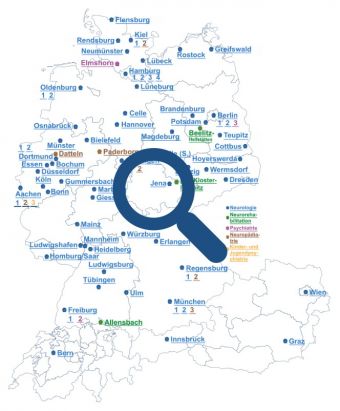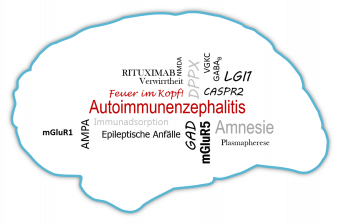How do we diagnose autoimmune encephalitides?
The clinical suspicion of autoimmune encephalitis is usually founded on the acute or subacute onset and rapid progression (<3 months) of short-term and working memory deficits, on a qualitative and quantitative impairment of consciousness or on the subacute onset of psychiatric symptoms reflected as personality changes, behavioral anomalies and affective disorders (Graus 2016). It is in this stage that diagnostics ought to be initiated to test for underlying autoantibodies in CSF and serum. Subclassification should be guided by the clinical syndrome and any additional findings. Occasionally, the diagnosis of autoimmune encephalitis can be rendered without demonstration of antibodies. This particularly applies when
- Signs of inflammation are found in the CSF (pleocytosis, extreme elevation in protein)
- MRI changes typical of encephalitis (uni- or bilateral T2-/FLAIR hyperintensities of the medial temporal lobe)
- Newly emergent epileptic seizures or a temporal focus of potentials typical of epilepsy in the EEG
AND - Important differential diagnoses (see Table below) can be ruled out.

Figure 1
Flowchart depicting the diagnosis and differential diagnosis of autoimmune encephalitides. For antibody diagnostics, see also “How are neuronal antibodies detected?”
For the most common form of autoimmune encephalitis—anti-NMDA-receptor encephalitis— the characteristic clinical course is nearly always concurrent with abnormalities in the CSF, thereby placing high diagnostic value on lumbar puncture. In more than half of the cases, the routine MRI scan of the brain is normal and often stands in striking contrast to the severe clinical picture exhibited by patients in the acute phase. Nevertheless, hyperintense and leukoencephalopathic changes are noted on the MRI, located mainly to the mesiotemporal, cortical, meningeal and in the basal ganglia (Heine 2018). In 90% of the cases, the EEG shows abnormalities, primarily diffuse slowing. Demonstration of anti-IgG-NMDAR antibodies in conjunction with the clinical syndrome secures the diagnosis of anti-NMDAR encephalitis.
The following clinical constellations are associated with a specific antibody at particularly high frequency or may even be pathognomonic for a certain form of autoimmune encephalitis:
- Newly emergent psychosis in adolescents or children → NMDA antibodies
- Fasciobrachial dystonic seizures (FBDS) → LGI1 antibodies
- Particularly high-frequency epileptic seizures / status epilepticus → GABAR antibodies (GABAAR > GABABR)
- Morvan syndrome, (painful) small fiber neuropathy → Caspr2 antibodies
- Parasomnia, sleep apnea, stridor → IgLON5 antibodies
- Therapy-refractory diarrhea, neuronal hyperexcitability → DPPX antibodies
How are neuronal antibodies detected?
Since most autoimmune encephalitides can also occur as a paraneoplastic syndrome, tumor diagnostics is indicated, informed by the clinical syndrome and the detected antibody.
Table: Selected differential diagnosis (*e.g. GAD; RhoGTPase-activating protein 26, Homer-3, mGluR1, cytosine arabinoside)
| Syndrome | Differential diagnosis |
|---|---|
| Subacute cerebellar degeneration |
|
| Limbic encephalitis (LE) |
|
| Opsoclonus-myoclonus syndrome |
|
| Retino-/opticopathy |
|
| Lambert-Eaton myasthenic syndrome |
|
| 5-FU = 5-Fluorouracil; ara-C = cytosine arabinoside; CIDP = Chronic inflammatory demyelinating polyneuropathy; CJD = Creutzfeldt-Jakob disease; EBV = Epstein-Barr virus; GBS = Guillain-Barre syndrome; HIV = Human immunodeficiency virus; HIV/PML = Progressive multifocal leukoencephalopathy in HIV; LHON = Leber's hereditary optic neuropathy; MSA = Multi-system atrophy; NMO = Neuromyelitis optica; PACNS = Primary angiitis of the CNS; SREAT = Steroid responsive encephalopathy with autoantibodies to thyroid; SLE=Systemic lupus erythematosu;VZV = Varicella zoster virus; WNV = West Nile virus | |
References
- Graus F, Titulaer MJ, Balu R, Benseler S, Bien CG, Cellucci T, Cortese I, Dale RC, Gelfand JM, Geschwind M, Glaser CA, Honnorat J, Höftberger R, Iizuka T, Irani SR, Lancaster E, Leypoldt F, Prüss H, Rae-Grant A, Reindl M, Rosenfeld MR, Rostásy K, Saiz A, Venkatesan A, Vincent A, Wandinger KP, Waters P, Dalmau J. A clinical approach to diagnosis of autoimmune encephalitis.Lancet Neurol. 2016 Apr;15(4):391-404.
- Heine J, Prüss H, Kopp UA, Wegner F, Then Bergh F, Münte T, Wandinger KP, Paul F, Bartsch T, Finke C. Beyond the limbic system: disruption and functional compensation of large-scale brain networks in patients with anti-LGI1 encephalitis. J Neurol Neurosurg Psychiatry. 2018 Jun 9. pii: jnnp-2017-317780.


